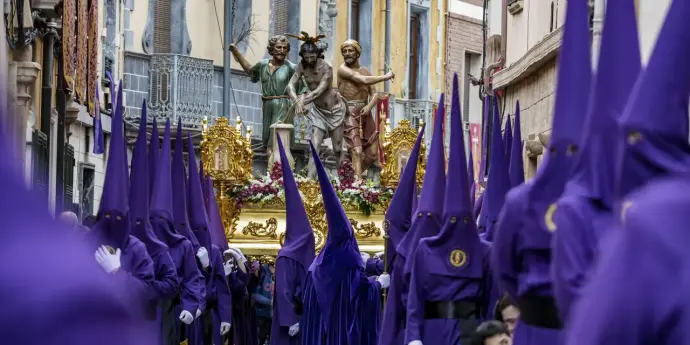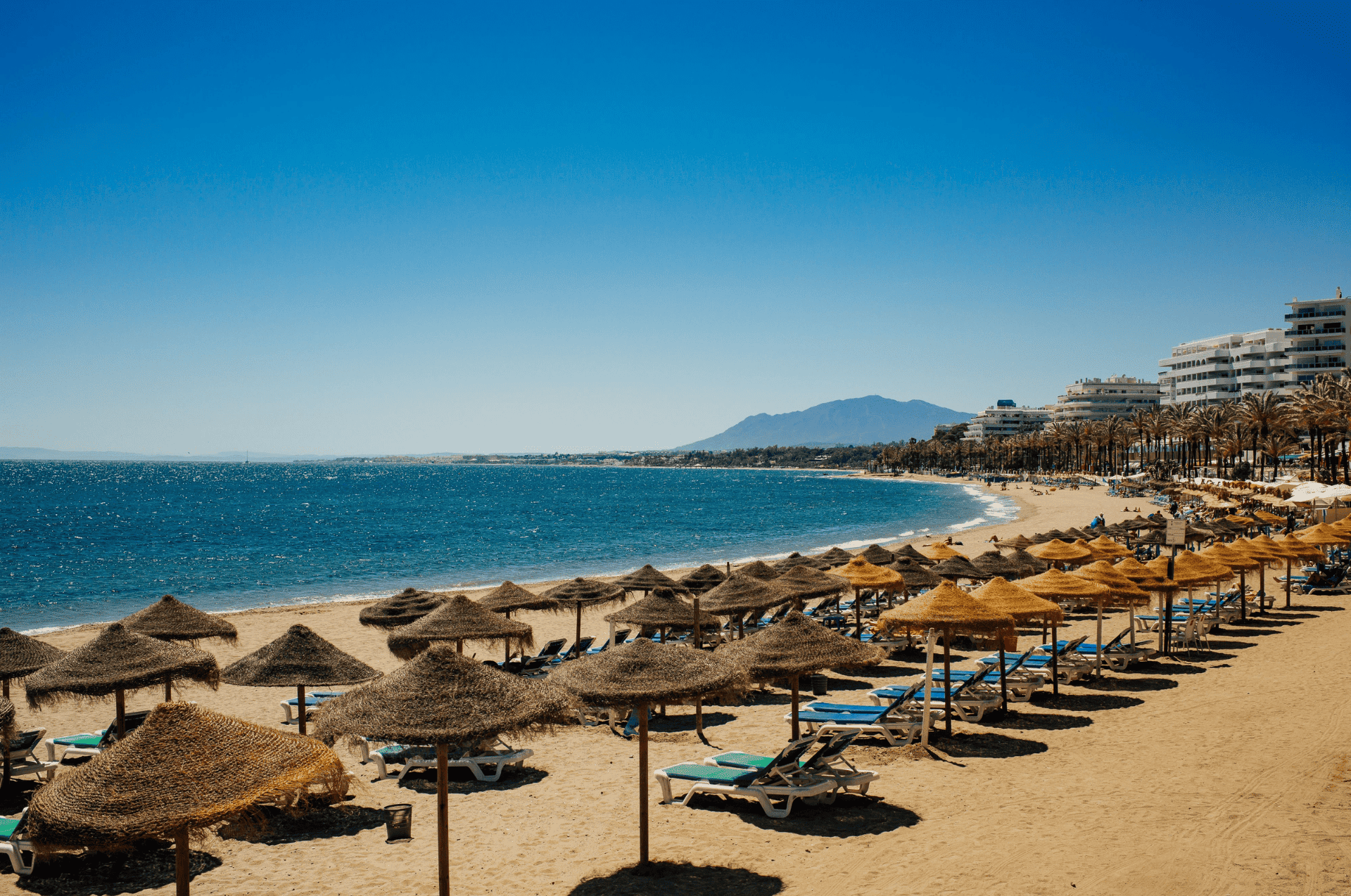Easter Week in Marbella is one of the most magical times of the year. The streets fill with devotion, music, and stunning processions that bring the Old Town to life with history and passion. If you’re visiting during Semana Santa 2025, here is everything you need to know:
What to expect during Easter Week in Marbella
Easter Week in Marbella is a deeply spiritual celebration full of emotion and tradition. You’ll witness solemn processions where penitentes (penitents), dressed in robes and hoods, carry heavy religious statues through narrow streets. The air fills with the scent of incienso (incense), while dramatic music from marching bands echoes through the town.
A memorable part of Easter Week in Marbella is the scent of incienso filling the air during processions. Traditional food plays a big role, too. Make sure to try torrijas a delicious dessert similar to French toast, soaked in milk, egg and sugar. Local bakeries and restaurants sell them throughout the week, so don’t miss out on this treat while you soak up the Easter atmosphere in Marbella.
Daily processions during Easter Week in Marbella
Each day of Easter Week in Marbella brings a unique procession that portrays a different part of the Passion of Christ.
Here’s what you can expect:
Sábado de pasión
Starts at 6:30PM from the Church of la Encarnación, with 86 members and 1 procession.
Key Moments:
- Calle San Francisco: “Petalada” (flowers thrown onto the float, creating a stunning visual effect)
- Plaza de la Iglesia: “Encierro” (when the procession makes its way through the church square)
Domingo de Ramos (Palm Sunday) — La Pollinica
Starts at 5PM from the Church of la Encarnación, with 450 members and 2 processions.
Key Moments:
- Calle Trinidad: Students sing to the sacred figures
- Plaza de la Iglesia: The meeting of the two images (Jesus and the Virgin)
Lunes Santo (Holy Monday) — El Cristo del Amor
Starts at 8:30PM from Ermita Santo Cristo, with 390 members and 2 processions.
Key Moments:
- Calle Ancha and Calle Lobatas: Traditional “saetas” (flamenco-style religious songs)
- Calle Aduar: Descent of the processions and a “petalada” (flower petals thrown onto the procession)
- Plaza Santo Cristo: Emotional encounter of the two images
Martes Santo (Holy Tuesday) — La Columna
Starts at 9PM from the Church of la Encarnación, with 310 members and 3 processions.
Key Moments:
- Plaza Puente de Málaga: Traditional “saeta” singing
- Plaza de la Iglesia: Meeting of the images and distribution of traditional sweets
Miércoles Santo (Holy Wednesday) — Nazareno
Starts at 8:30PM from the Church of la Encarnación, with 300 members and 2 processions.
Key Moments:
- Plaza Puente de Málaga: Traditional “saeta” singing
- Plaza de la Iglesia: Meeting of the images and distribution of traditional sweets
Jueves Santo (Maundy Thursday) — La Vera Cruz
1. Hermandad del Calvario
Starts at 5:30PM from the Church of La Encarnación, with 150 members and 1 procession.
Key Moments:
- Plaza Puente de Málaga: Traditional “saeta” singing
- Plaza de la Iglesia: Emotional procession through Marbella
2. Hermandad de La Soledad
Starts at 8:15PM from the Church of La Encarnación, with 300 members and 1 procession.
Key Moments:
- Plaza de la Iglesia: Spanish Legion escorts
3. Cofradía del Cristo del Amor
Starts at 11:30PM from the Chapel of Santo Sepulcro, with 120 members and 1 procession.
Key Moments:
- Plaza Puente de Málaga: Emotional reflections
- Avenida Ramón y Cajal: Spectacular view of the procession
Viernes Santo (Good Friday) — Santo Entierro
1. Santo Sepulcro
Starts at 9:00 PM from the Church of La Encarnación, with 150 members and 2 processions.
Key Moments:
- Plaza Puente de Málaga: Emotional “saeta” singing
- Avenida Ramón y Cajal: Procession passes through this iconic street
2. Soledad
Starts at 9:30 PM from the Chapel of Santo Sepulcro, with 120 members and 1 processions.
Key Moments:
- Plaza Puente de Málaga: Moving procession as it crosses the square
- Plaza de la Iglesia: Meeting of the images with solemn moments of reflection
Domingo de Ramos (Easter Sunday) —
April 20th – Starts at 10:30PM from the Church of la Encarnación, with 3 processions.
Key Moments:
- Plaza de la Iglesia: The procession culminates with a meeting of the images, marking a moment of reflection and devotion
You can read more about the itineraries here.

Best tips for enjoying Easter Week
Arrive early: The streets get crowded quickly, especially on Palm Sunday and Good Friday.
Best locations: Head to Plaza de los Naranjos and the narrow streets of the Old Town (Casco Antiguo) for a charming backdrop.
Smaller processions: Explore the Old Town for more intimate processions where you can experience the devotion up close.
A little history of Easter Week in Marbella
Easter Week in Marbella has deep roots in Andalusian tradition. Known locally as Semana Santa, it began in the late Middle Ages when religious brotherhoods began organising solemn processions. These brotherhoods, or cofradías, were formed to educate the public about the Passion of Christ at a time when many couldn’t read. Through vivid imagery, music and ritual, they brought the story of Holy Week to life.
Over the centuries, the tradition grew into a powerful expression of faith, identity and community pride. Each cofradía spends the entire year maintaining ornate floats, sewing intricate robes, and perfecting every detail of the processions. These brotherhoods often consist of multiple generations, adding a personal touch to the celebrations.
What makes Easter Week in Marbella unique is its combination of heartfelt devotion and the town’s picturesque coastal setting. Against a backdrop of whitewashed houses, narrow cobblestone streets and vibrant plazas, Marbella’s processions create an unforgettable atmosphere. The scent of incense fills the air, solemn drums echo through the Old Town, and golden sunsets cast a soft glow on the festivities.
Must-see highlights
Easter Week in Marbella is filled with unforgettable moments. One of the most moving is the traditional saeta — a powerful flamenco-style prayer sung from balconies as floats pass below. These spontaneous songs add raw emotion to the already intense atmosphere. Another highlight is the levantá, when costaleros lift the heavy floats in unison, to the applause of the crowd. Watching the brotherhoods carry intricate pasos through Marbella’s narrow streets is a feast for the senses.
What to wear for Easter Week
Comfortable shoes are a must, as you’ll be walking or standing for long periods through Marbella’s cobbled streets. While the days can be warm, evenings in Marbella can be unexpectedly cool, especially during the processions. A light jacket or sweater is recommended. Dressing modestly is a sign of respect for the religious and cultural event, so avoid overly casual or revealing clothing. A modest yet stylish outfit will help you blend in seamlessly with the locals.
Stay in the Heart of Marbella
Make your Easter unforgettable by booking a rental with Roccabox. We offer luxury apartments and villas close to the Old Town and prime viewing spots, so you will be just steps away from the processions. Whether you are looking for a romantic escape or a family holiday, Roccabox has the perfect property for you during Easter Week in Marbella.
Stay tuned to our blog for more easter events!
Contact us today to book your dream stay and experience the magic of Easter Week in Marbella.


